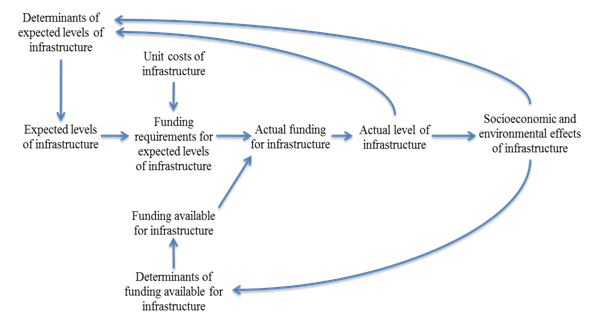International Futures Help System
Infrastructure
Overview
The current version of the infrastructure model within IFs was developed in concert with the production of Building Global Infrastructure, the fourth volume in the Patterns of Potential Human Progress series (Rothman et al 2013). Further details on the model and analyses can be found in that volume.
The purpose of the infrastructure model is to forecast the following:
- the amount of particular forms of infrastructure;
- the level of access to these particular forms of infrastructure;
- the level of spending on infrastructure; and
- the effect of infrastructure development on other socio-economic and environmental systems
The infrastructure model includes parameters that allow users to explore a range of alternative scenarios around infrastructure. These can be used to ask questions such as:
- What would be the costs and benefits if countries were to accelerate infrastructure development above that seen in the Base Case?
- What if the unit costs of infrastructure development or infrastructure lifetimes were to differ from the assumptions used in the Base Case?
- What if the impacts of infrastructure development on economic productivity and health were to differ from the assumptions used in the Base Case?
Unlike many previous studies, which estimate only the demand for infrastructure, IFs forecasts a path jointly determined by both the demand for infrastructure and the funding available to meet that demand. Therefore, the amount of infrastructure forecasted in IFs in each year explicitly accounts for expected fiscal constraints. Furthermore, the socio-economic and environmental effects of infrastructure feed forward to the drivers of infrastructure demand and supply in future years.
The figure below provides an overview of the infrastructure model within IFs. In brief, the infrastructure modeling in IFs involves moving through the following sequence for each forecast year:
- Estimating the expected levels of infrastructure
- Translating the expected levels of infrastructure into financial requirements
- Balancing the financial requirements with available resources
- Forecasting the actual levels of attained infrastructure
- Estimating the social, economic, and environmental impacts of the attained infrastructure
Each of these steps are described in more detail below.

For more on the infrastructure module, please click on the links below.
- Structure and Agent System
- Dominant Relations
- Initializing the Infrastructure Data
- Flow Charts
- Equations
 International Futures at the Pardee Center
International Futures at the Pardee Center